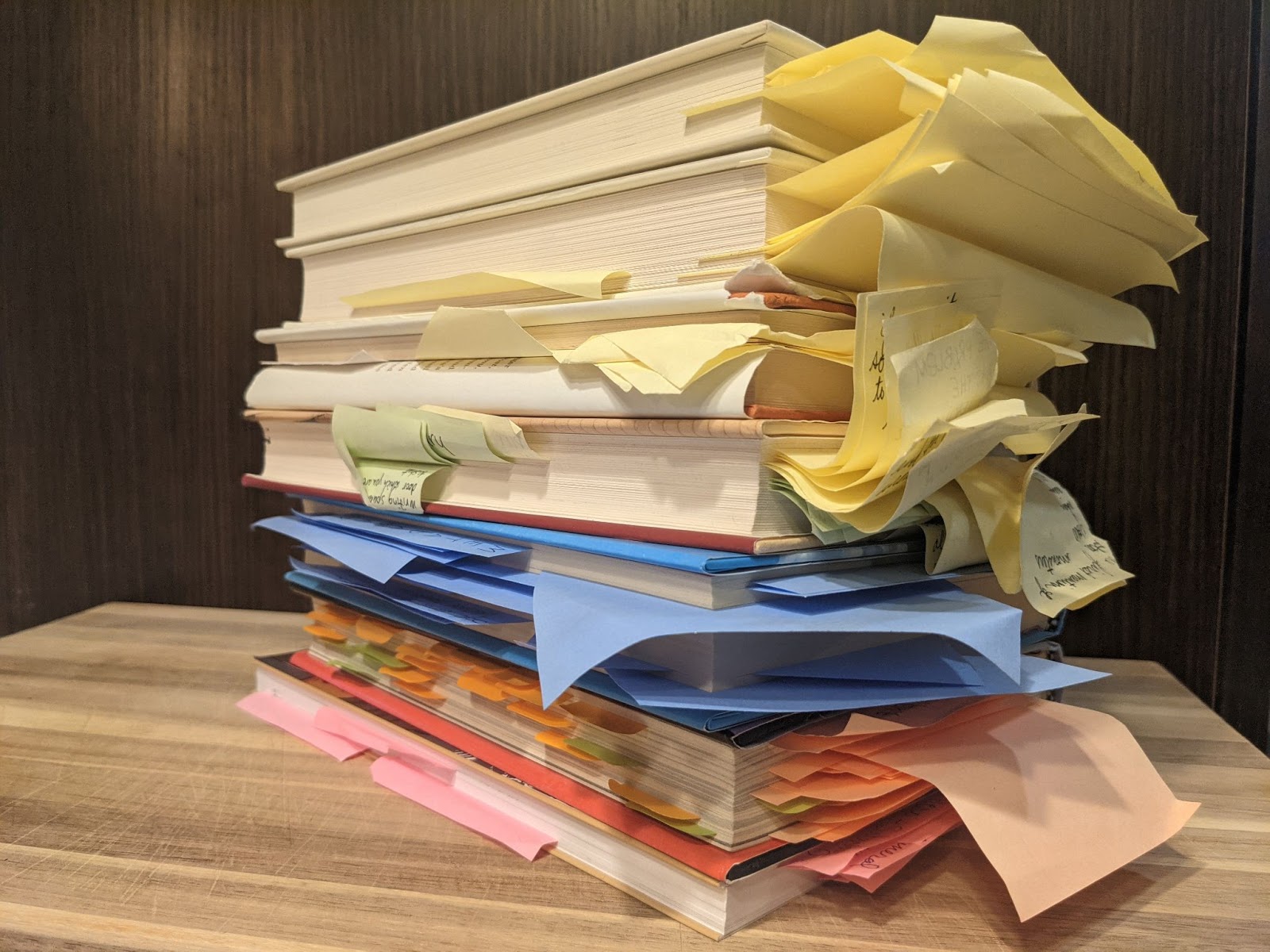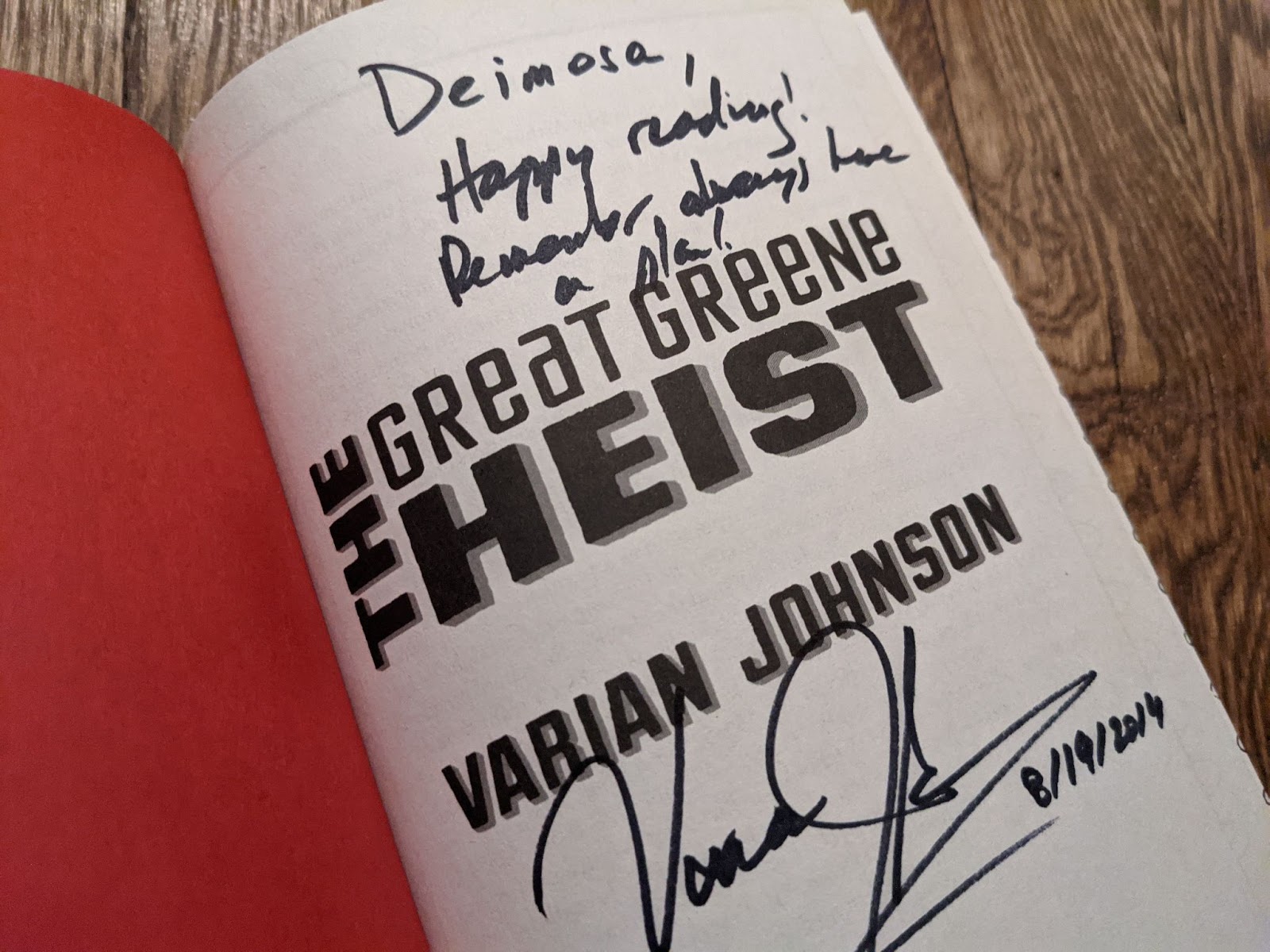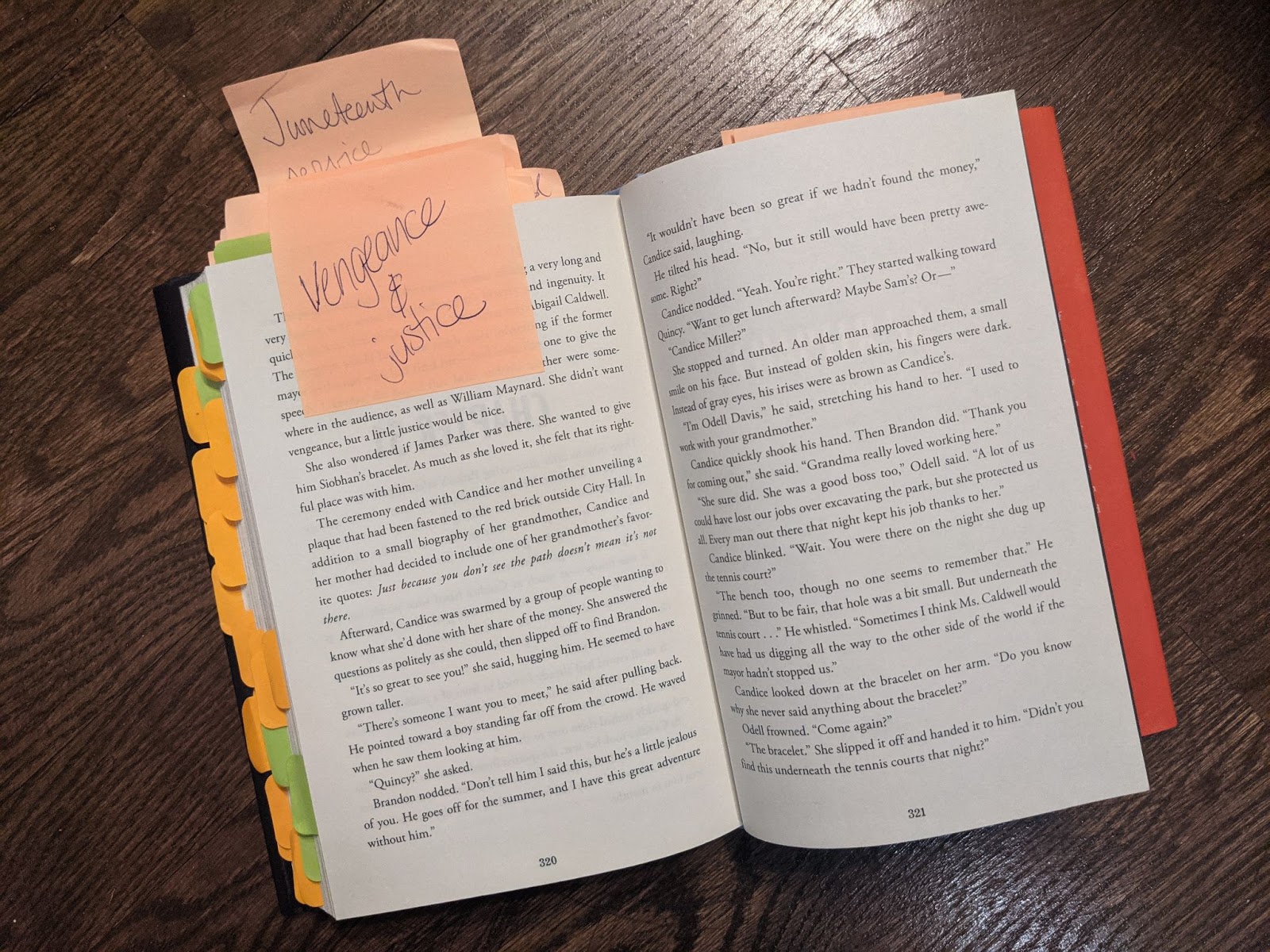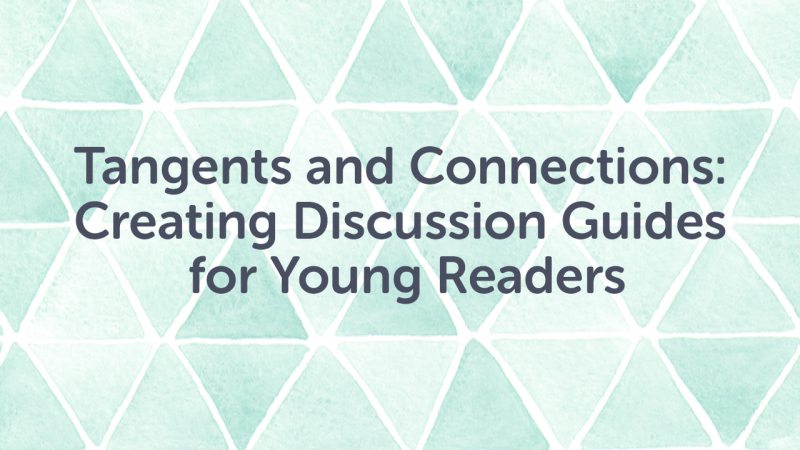While reading The Parker Inheritance, I place a sticky note on page 98, which marks the opening of a Juneteenth celebration. The words on the facing page warm my heart:
“Halfway through, the drums came in.”
The sentence reminds me of my dad, a fan of HBCU marching bands. Wondering if I should develop lesson ideas for music teachers on the cultural significance of the drum, I place another sticky note on this page. It is a 3x3” pastel orange square affixed to the top of the page, and it marks a significant plot moment for me - writer of the discussion guide.
There are several other sticky notes involved in my method; the system changes based on the book and what colors and sizes I have on hand. Juneteenth is not the central topic of this book, however a teacher could use this moment as the basis of a text-to-world connection and a lesson on the history of this emancipation and freedom day celebration. Later on, I will double-check the standards for ELA and social studies for learning ideas, and also research national standards for music education to see what is recommended for grades three to seven. Having been a teacher myself, I want to provide lesson ideas that:
- Are interesting!
- Hit the learning standards best I can
- Scale up and down based on student ability and classroom size
- Offer both tactile and kinesthetic learning opportunities
Make text connections: text-to-text, text-to -self, and text-to-world
The discussion guides I have written so far have been an honor to do. Specifically, I wrote the guide for The Parker Inheritance, and I revised and updated the guide for The Buxton Chronicles. Having double-majored in English Literature and African & African American Studies, with a masters in education and library science, and having taught and librarianed, it feels like all of my experience and training go into these documents. The fact that these titles are Coretta Scott King, National Book Award, and Newbery honor recognized titles is also not lost on me. These books communicate the Black experience in the Americas in a way that adds depth and fills in the gaps. Fleshing out the discussion guide allows me to uplift small details that support the story, but are also worlds of information - tangents just waiting to be explored.
To write a discussion guide, I read the book at least twice cover to cover. The first time I am reading to find out what happens, and welcome surprises like a Juneteenth scene and other major moments in the story get big sticky notes at the top of the page. The second time I read it, knowing the end, the sticky notes are placed on the side of the page and mark aspects of the storytelling - how the author tells us what happens. I’ll mark narrative devices, subtle references, recurring themes, hints and more with a second color sticky note. This one may be the same size, but it is definitely a different color, and if I was preparing for a book club discussion this would be it. However, for a discussion guide there is a third and final sticky note that I use, and that is for vocabulary and word usage.

The next thing I ‘mark up’ is curricular standards. Depending on the audience and the grade level of the book, I will visit the Common Core State Standards Initiative website and the American Association of School Librarians Standards Framework for Learners. As I (re)read through them, I will note standards that are most relevant to the plots and themes of the book on lists with headings for English language arts and social studies, hopefully also mathematics and science. Being a librarian, I will create a list with ideas for my fellow school informationists and investigate any additional subjects that connect to the story.
For The Parker Inheritance, the plot revolves heavily around a single tennis match, which allowed me to stretch and suggest physical education lesson ideas. Why not use this opportunity to introduce tennis? Sitting at home writing this during the pandemic also forced me to be more creative - how could tennis be taught virtually? Using a computer or video game, or maybe even an app, a gym teacher could still remotely teach the sport and its jargon, even engage students in a tournament... They could share the history of Black tennis players with vintage footage of them playing on the web... I make a note to look up physical education standards.
Putting pen to paper to actually write the discussion guide is a struggle for me, you can ask my colleagues who are forever patient as I miss deadlines to turn something in. Discussion writer’s block is a thing; I am intimidated by the enormity of the audience and task in front of me. I know it is but a shadow of that of Christopher Paul Curtis and Varian Johnson, who reach millions. Still, if even a mere one hundred teachers try these lessons, they’ll be done with thousands of kids. Should they reuse them for a few years the number magnifies. I know the reach of these lesson plans because I work in the Scholastic Library and Archive. One of the most frequent information requests we get - which predate my beginning at Scholastic in 2012 - are from teachers who have lost or misplaced the lesson plans that go along with one of their favorite Classroom Magazines articles, that they teach with year after year. I need the discussion guide to stand the test of time. What if they put it in the backmatter of a future paperback edition?
For this guide in particular, it was important to me to put myself in the shoes of my fellow educators. Introducing and discussing how and why people have been historically marginalized is one of the toughest parts of teaching, so the guide opens with ideas for addressing social emotional learning and answering tough questions. I also wanted to create a meaningful pre-reading activity that students could revisit throughout the duration of the unit. Being a librarian I loved the research that goes into detective work and solving mysteries, there is always almost a scene in the library or on a web browser. Keying in on the yearbooks that are key elements of the story, my own online research led to learning about the North Carolina Digital Heritage Center, where they are “actively digitizing African American high school yearbooks up through their closure or integration.” Creating this pre-reading activity influenced me to keep going with the yearbook theme and offer the creation of one as a post-reading activity.
One overthinks things, but devoting time to this discussion guide during the tumult of 2020 was incredibly meaningful. I am a huge fan of Varian Johnson’s work, especially Twins and The Great Greene Heist, which I had everyone read in our employee book club. We even got the editor to join us for the conversation. I am super excited of course for Playing the Cards You’re Dealt, where the main character plays in a Spades tournament, which is being published in October 2021. Taking my autographed copy of The Great Greene Heist off the top shelf last summer, I reflected on Varian Johnson’s CSK acceptance speech. We all shed tears as he addressed his daughters, and only his daughters, pointing out that all of the authors, illustrators, and book makers in the room were there to support them, an experience that makes me feel even more pressure to do his discussion guide justice. Varian Johnson has high expectations, and I share his sense of urgency. I open the book to see what he inscribed and see this:

Deimosa, Happy Reading! Remember, always have a plan! - Varian Johnson 8/19/2014
Gah! I was not overthinking anything. I finally started typing.
There is so much more to say, and there are so many more discussion guide questions and lesson ideas I could develop if there were no deadlines. I joke that I can create a lesson on any subject for The Parker Inheritance, but the reality is that I taught 4th, 8th, 9th, 10th, 11th, 12th graders and adults as far as age levels, and ELA, math, personal wellness, reading, college prep, common branches and GED as far as subjects. Remembering that I don’t need to spell out the details to my peers, who write lesson plans every day, I pare my ideas down to single sentences and bullet points, spelling out URLs fully for those who will use this as a print document. There are at least three ideas per subject, and at least four subjects beyond ELA. Just the right number of vocabulary words… page numbers are a must, as well as citations of all the standards addressed in each lesson, to save time for the teacher. Then I email it to my peers in Trade with profuse apologies for the extra weeks it took.
Total sticky note count:
- Major moments: 25
- Aspects of storytelling: 7
- Vocabulary: 20




